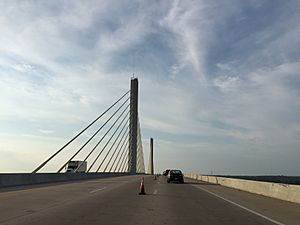Varina-Enon Bridge facts for kids
Quick facts for kids Varina-Enon Bridge |
|
|---|---|
 |
|
| Carries | 6 lanes of |
| Crosses | James River |
| Locale | Chesterfield and Henrico counties, Virginia |
| Maintained by | Virginia Department of Transportation |
| Characteristics | |
| Design | Cable-stayed bridge |
| Total length | 4,680 feet |
| Width | 109 feet |
| Height | 150 feet |
| Longest span | 630 feet |
| Clearance above | 409 feet |
| Clearance below | 150 feet |
| History | |
| Opened | July 18, 1990 |
| Statistics | |
| Daily traffic | 38,977 (2002) |
The Varina-Enon Bridge is a special kind of bridge called a cable-stayed bridge. It carries Interstate 295 over the James River in Virginia. This bridge connects Henrico County (near Richmond) with Chesterfield County (near Hopewell, Virginia). It first opened to traffic in July 1990.
This important bridge has six lanes, with three lanes going in each direction. It also has wide shoulders on both sides for safety. The bridge is very tall, giving 150 feet (46 meters) of space for ships to pass underneath. It stretches 4,680 feet (1,426 meters) long. The Varina-Enon Bridge crosses a shipping channel that leads to the Port of Richmond.
The Virginia Department of Transportation (VDOT) owns and takes care of the bridge. Its name comes from two nearby places: Varina, which was once the main town of Henrico County, and Enon, a small community in Chesterfield County. In 1993, a strong tornado caused some damage near the bridge, but the bridge itself remained strong.
What is a Cable-Stayed Bridge?
The Varina-Enon Bridge is a cable-stayed bridge. This means its road deck is supported by strong cables. These cables connect directly from the deck to tall towers. This design is different from a suspension bridge, which uses main cables draped between towers.
The Varina-Enon Bridge was the second major concrete cable-stayed bridge built in the United States. The first was the Sunshine Skyway Bridge in Florida, finished in 1988. This type of design was chosen for the Varina-Enon Bridge because it needed to be very high. A high bridge was important to let large ships pass easily below.
Engineers wanted to avoid building a drawbridge, which opens and closes. This decision came after a ship hit the Benjamin Harrison Bridge nearby in 1977. That accident closed the bridge for over a year. When it opened, the Varina-Enon Bridge was the tallest bridge in Virginia. It stood 157 feet (48 meters) high. Today, it is the third tallest bridge in the state.
The Varina-Enon Bridge looks a lot like the Senator William V. Roth Jr. Bridge in Delaware. That bridge was also built around the same time.
Peregrine Falcons: A Special Home
Eastern Virginia is home to many birds, including rare ones like eagles and peregrine falcons. The Virginia Department of Transportation (VDOT) learned something amazing. They found that their tall bridge structures are perfect nesting spots for these birds. The bridges are like the high cliffs and tall trees these birds love.
VDOT started a special program to help these rare birds. They put nesting boxes on several bridges. This program has been very successful. About 30 percent of all peregrine falcons in Virginia now live on these bridges. In 2003, many peregrine falcon chicks hatched on VDOT bridges. This was a big win for the endangered species.
Most of the baby falcons, called "eyases," were taken from their nests. They were banded and then released into the wild. Banding helps scientists track the birds. Sometimes, one chick is left with its parents. However, chicks often have a better chance of surviving when released into nature. One worry is that a young falcon learning to fly might fall onto the bridge or into the water. Bridge workers keep the Center for Conservation Biology at the College of William and Mary updated on the birds' movements.
Peregrine falcons were listed as endangered in 1970. At that time, almost none were left in the eastern U.S. Their numbers had dropped by 80 to 90 percent across the country. Starting in the 1970s, a big effort began to help them recover. Thanks to conservation work, like VDOT's program, their population has grown a lot. Today, over 1,500 breeding pairs live in the U.S. and Canada.
VDOT works with the U.S. Fish and Wildlife Service and other groups. They watch the falcons on each bridge to make sure they are healthy. VDOT even has special rules for bridge building. These rules help protect falcon nesting sites.
Nesting boxes have been placed on 10 VDOT bridges, including the Varina-Enon Bridge. Because of this, peregrine falcons, known as the world's fastest birds, fly high over Virginia again. VDOT won an award in 1998 for its important role in helping these falcons.

